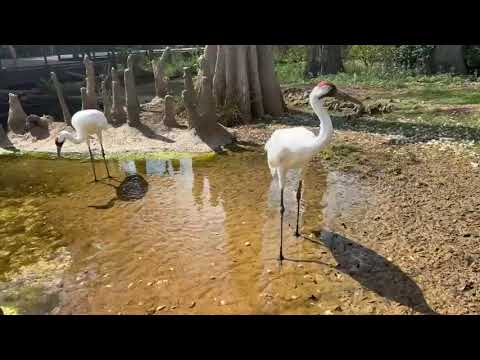*****
Summary of Transcript:
The video features Kira, a bird keeper at the Houston Zoo, talking about the two whooping cranes they have in the wetlands area named Haydn and Angel. Just like humans, birds have their own personalities with Haydn being more outgoing and Angel being more reserved. The cranes are munching on different types of food including smelts, crickets, and peanuts. They are both over 16 years old and have a lifespan of up to 30 years in captivity. Unfortunately, whooping cranes are endangered due to habitat loss, hunting, and pollution. Organizations have created a safe refuge for the cranes where they can migrate to, find food, and raise their chicks. The Houston Zoo helps to conserve these cranes with the money they earn and by recycling. Kira also talks about how she enjoys working with the cranes because of their personalities and interactions with each other.
*****
Summary of Description:
The population of whooping cranes declined to 20 in the 1930s but has since recovered, with around 800 wild cranes today thanks to the Endangered Species Act and efforts in Texas. A pair of these cranes, Heiden and Angel, can be seen in the Kathrine G. McGovern Texas Wetlands.
*****
What Happened to the Whooping Cranes?
It seems like a mystery that the whooping cranes, once populous birds, have dwindled to such a small number. By the 1930s, the population of the whooping cranes had dropped to an anxious 20 birds. As humans, we should feel responsible for endangering these birds at the brink of extinction. Our efforts have paid off, and their population has bounced back to 800 wild birds that visit Texas from Canada every year.
The Significance of the Endangered Species Act
Thanks to the Endangered Species Act of 1973, the whooping cranes have been under the radar of conservationists. The ESA ensures that threatened and endangered species in the United States get protection and recovery plans. The law has saved many species from extinction, and it couldn’t be more relevant than in the case of the whooping cranes.
Texan Efforts To Save The Whooping Cranes
Texans have played a significant role in the conservation of the whooping cranes. The birds migrate to the Texas coast every year, and Texans have made their habitat accommodating. The construction of the Kathrine G. McGovern Texas Wetlands provides a safe haven for the birds. Heiden and Angel are a renowned pair of whooping cranes that can be spotted in the wetlands.
Final Thoughts
It’s a cause for celebration that the whooping cranes population has risen to 800. However, it would be best if we continued to put in the effort to conserve them. The decline of the whooping cranes serves as a reminder that we have to take care of our planet and the species that dwell in it. Whether it’s taking care of our water bodies, avoiding the use of pesticides, or reducing our carbon footprint, we can all play a role in conservation efforts. With continuous efforts like these, we can ensure that endangered species like the whooping cranes thrive for generations to come.
*****
See Original Source
Source Description
There used to be more than 10,000 whooping cranes in the wild, and by the 1930s, their population had declined to only 20. Today, there are about 800 wild whooping cranes that migrate to the Texas coast from Canada, thanks to the Endangered Species Act and the efforts of Texans. You can spot our pair, Heiden and Angel, in the Kathrine G. McGovern Texas Wetlands.
[vid_tags]


